Small World
Facing Impossible Challenges
CHAGRIN FALLS, Ohio — Dr. Ron Siwik had a choice to make: Comply with an air-traffic controller who demanded he deviate from his flight path. Or ignore the voice on the radio and risk immediate peril in one of the world’s most hostile nations.
This is the decision he faced in Rangoon, Myanmar, on his 24,604-mile, around the world solo flight in 2008.
“They were sort of making impossible demands, and I was very concerned about—well, I didn’t want to comply. And I was very concerned about a Burmese fighter intercepting me and forcing me down,” Ron said.
The Myanmar government did not want him flying over the Irrawaddy Delta, which in May 2008 was devastated by Cyclone Nargis. Ron was adamant that he was too far up in the clouds to see down into the Delta anyway, so he made the choice stay on course. The threatened Myannmar fighter jet never appeared. It was the only major spot of trouble faced during his 56-day, 30 years in the making adventure.
Facing impossible challenges seems a regular feature of Ron’s life, though in his case the demands are self-imposed. After all, this is a man who decided to learn how to fly while simultaneously completing his residency in radiology at Ohio State University. A man who purchased his first airplane, a 1966 Beechcraft Bonanza, during the 1973 oil embargo. And a man who, having read a book about the Bermuda Triangle two months after he bought the Bonanza, turned his first international trip into a family vacation to the Triangle.
A One-Woman Support Network
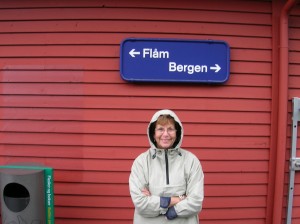
Rita Siwik's support and coordination helped to make her husband's 56-day adventure a success.
Luckily for Ron he has found a partner who both supports and encourages his love of aviation in Rita, his wife of almost 50 years. The two met in 1959 whenRita was a student at Western Michigan University, and Ron was a student at Kalamazoo College. Ron’s best friend from high school was dating the girl across the hall from Rita. Ron and Rita married in 1962. “I had no idea he was interested in flying when we were married,” Rita said. Today Ron credits Rita with contributing to the fulfillment he gets from flying. “The fact that my wife supported it is crucial. There’s almost all of the people out at the airport, all of the men, have wives that are not supportive.”
A Home Away From Home
The airport Ron refers to is Portage County Airport in Ravenna. He and Rita, who make their home in Chagrin Falls, bought a hangar at the airport in 1987.
The exterior looks like a giant red barn in a collection of other giant red barns. It is here that Ron keeps the white 1966 Bonanza; a cherry red 1977 Pitts Special aerobatic plane, bought brand new; an antique yellow 1946 Piper Cub two-seater purchased in 1988; and his newest favorite, a 300 CBI helicopter bought brand-new five years ago.
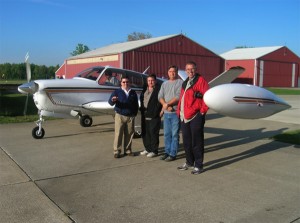
The around-the-world ground crew: Mike Carroll, Jerry Novak, Jeff Cales, Jim Siwik.
Though it may look like a barn from the outside, the couple has turned the interior into quite the area of homey comfort. The eye is immediately drawn to four aircraft, arranged like puzzle pieces wing-to-wing-to-wing-to-rotor blade. In one corner there is a small open bedroom and in another a writing area.
In between there is a bathroom, and up a short flight of stairs, Ron’s office. A flat screen, desk and comfortable chairs complete the room; but it is the trophies won during aerobatic competitions in the Pitts Special that he points out with pride. These are kept on a ledge of the large window that overlooks his four aircraft.
It is not just the furniture that makes the hangar feel like home. Every inch of wall space is covered in personal mementos. An extra pair of wings for the Pitts Special line one wall. Photos of Ron’s favorite planes from World War I, World War II and the Vietnam War, placed chronologically, line another. A framed map with tiny black-topped pushpins displays the trips the family has taken over the years, and hangs next to a map of Ron’s round the world trip. Completing the wall is the pilot uniform shirt Ron wore during his solo flight, with his captain’s hat perched on the top right corner of the frame. Before embarking on his solo trip, Ron was told he needed to be in a pilot’s uniform once he got out of the U.S., because he needed to look official.
Rita finally calls special attention to all the family pictures of their three children and nine grandchildren, and the artwork of planes drawn and painted by the children over the years. Ron affectionately refers to the hangar as his “man-cave.” It is here where he plans to enjoy his retirement from medicine, an event he celebrated in January.
A Life-Long Love Is Born
What drew Ron to aviation in the first place? “I grew up during the ‘Golden Age’ of aviation, which is from Lindberg until the ʼ50s,” Ron said. “Pilots were kind of the rock stars of the ʼ30s and ʼ40s.” This childhood love of aviation finally manifested itself in the 1960s when Ron took flying lessons for the first time at Brooks Air Force Base in San Antonio. As a young doctor graduating during the Vietnam War, he knew he would be drafted. Instead of waiting for the inevitable, he enlisted in the Air Force, going in as a captain and serving from 1967 to 1969. It cost $7/hour to rent a plane and $5/hour for an instructor on the base, a rate that was “even cheap for those times,” Rita said.
Today, he is certified as an instrument rated Airline Transport Pilot (ATP) and Flight Instructor (CFII) in single- and multi-engine airplanes, seaplanes and helicopters. As their son and two daughters got older, the couple began to realize how beneficial Ron’s being a pilot could be for the family and the type of lifestyle they wanted. As he settled into professional life, Ron made the switch from practicing family medicine in the Air Force to radiology.
“If you specialize, you get to see sick people. It’s a little more challenging, I think you might say,” Ron said. Like flying, switching specialties was a risk, one that Ron said was the best decision for him. After 43 years of flying, the couple can still clearly pick out their favorite trips. For Rita, it was the first time they flew over the water, from Florida to the Bahamas. “It was just, so beautiful, and a completely new experience seeing it from the air.”
Ron said his favorite trip was flying from Aspen to Mexico City in January 1979, because of the Rockies poking up out of the clouds. And then, of course, there was also that around the world trip.
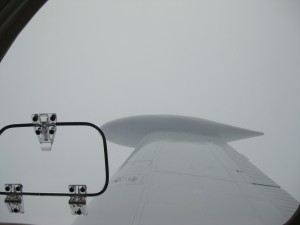
100-gallon auxiliary fuel tanks were added to the wings of the single-engine Beechcraft Bonanza to make the ocean crossing possible.
A Flight Around The World
Physician and flier are perhaps the two best ways to describe Ron, but avid reader comes in a close third. “It was so nice to have grown up before television, and developed the reading habit as a child,” he said. This love of reading led him to writings on Lindbergh’s trek around the world and Louise Sacchi’s Ocean Flying, books that prompted him to put into action the simmering thought of flying around the world. Or as Ron affectionately refers to the endeavor, the “Super Bowl” of aviation. He told himself “once I did that, I can relax.”
“It’s like the final Holy Grail,” he said. After 30 years of just thinking about it, in 2006 Ron sat down and began to plan out the trip. For help with logistics, he contacted Skyplan Services Ltd., a company that works more often with corporations than individual pilots like Ron.
“Those people were just indispensable,” he said. In the beginning he planned to have a co-pilot, with Rita his first choice. She declined, not wanting to be away from family that long and knowing she had no desire to be cooped up in a plane for 15-hour stretches. Two other friends said no, and Ron resolved he would make the trip solo. Jerry Novak, Ron’s mechanic for 27 years, thought he was insane to try the flight.
“Why would anybody want to fly a single-engine airplane around the world,” he said. In fact the week before Ron was to depart, May 22, the entire engine of the 1973 Bonanza was removed because of an oil leak. Completing the repairs required working through the night, and, according to Jerry, there were no major mechanical issues during the trip.
Ron took off May 23 and headed west. After a couple of overnight stops in Hawaii he flew to Manila, meeting up with an old friend who flew in from the States. Indulging his inner history-buff, he visited famous World War II sites. Plans to tour his old war haunts in Vietnam instead turned into days spent resting in the hotel while enjoying a good book.
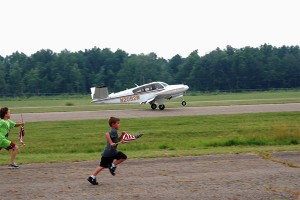
The Bonanza touches down on Portage County Airport's runway 27 as Ron Siwik arrives home.
Sightseeing in India turned into a 72-hour race against the visa-expiration clock as Ron got bogged down in administrative headaches and a demand for $1,500 per barrel of fuel. After that headache, the reception awaiting him in Oman, located on the southeast coast of the Arabian Peninsula, seemed heaven-sent. He called the country “superb” and its people “the finest examples of humanity.”
His next stop in Cairo, Egypt, will be remembered for providing the best hotel of the trip, the Heliopolis. Rita joined Ron in Greece for a 10-day stay in Athens, Santorini and Crete to celebrate their anniversary. The food was magnificent, they said, and the view from their hotel room could make you weep with envy.
Next came “the suburbs,” as Ron fondly recalled Europe. A stop in Lisbon, Portugal, was necessary because of its history as the birthplace of some of the world’s greatest explorers. As he neared the end of his journey, back on North American soil in St. John, Newfoundland, Canada, he wanted to celebrate with a bottle of champagne. In his dispatches from the journey, he remembers calling the front desk for a bottle, and a surprised attendant questioning why one person would want a whole bottle of champagne himself. Perhaps celebration is lost on the Canadians.
Ron and Rita talked by satellite phone, twice a day, after which she would pass on tidbits from their conversations to family and friends via email. Ron never really worried about his safety during the trip. “My biggest worry was a broken ankle, or twisted ankle, or a broken wrist. Everywhere I went, I watched my step. I didn’t want to leave the airplane. I didn’t want to be delayed for a cast, waiting for something broken to heal,” he said.
Rita said she was often asked how she could just let her husband go off on his own. “My answer is always, ‘How can you stop somebody’s fulfilling a dream?’ You can’t stand in their way.”
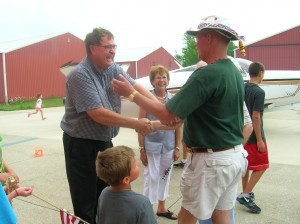
Pilots, friends and family are all waiting at the hangar to celebrate Siwik's safe return.
A Feeling Of Contentment
Ron is a northern Ohio treasure; albeit one too few people know about. His life is an incredible story, hidden behind a kind face that finally feels contentment with his numerous accomplishments. Today he is happy to just take his aircraft out whenever the mood strikes him—which of course is usually every day. “I’m in nirvana,” he said.
Lisa Robertson is a second-year magazine journalism graduate student at Kent State University. She received her bachelor’s in history from Wright State University in 2007. Her work has appeared in Plastics News, Thunder Press, the Daily Kent Stater and The Burr magazine.
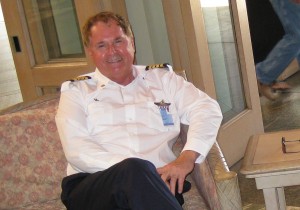
Sorry, the comment form is closed at this time.